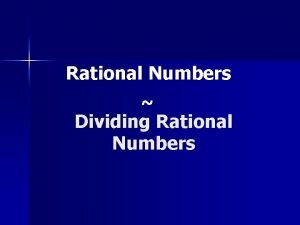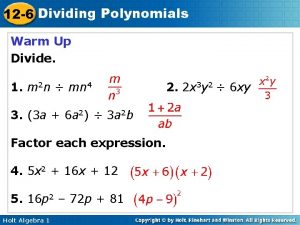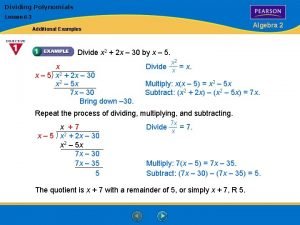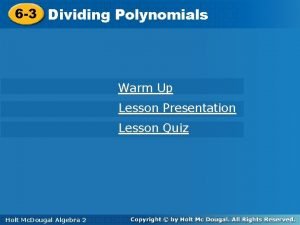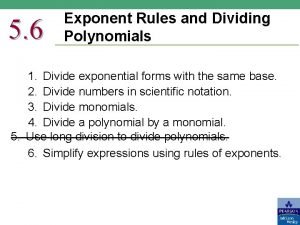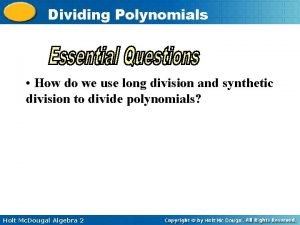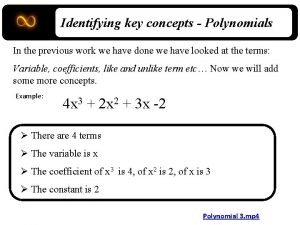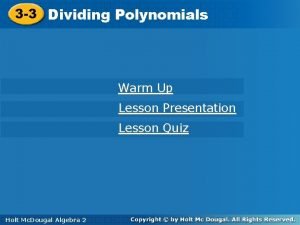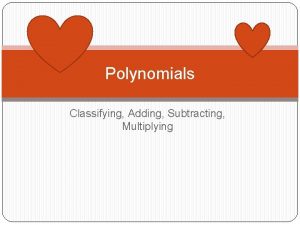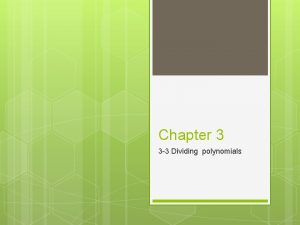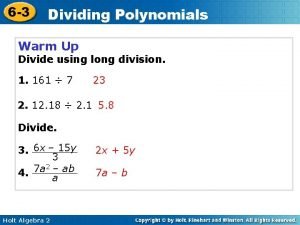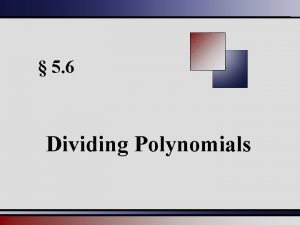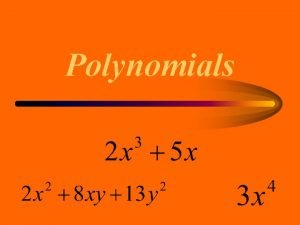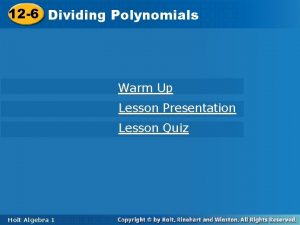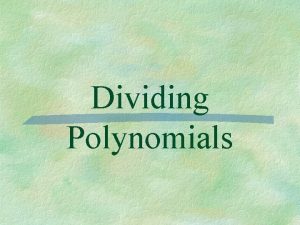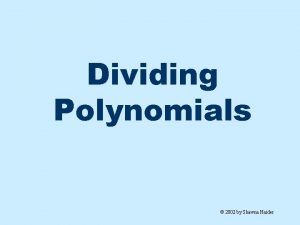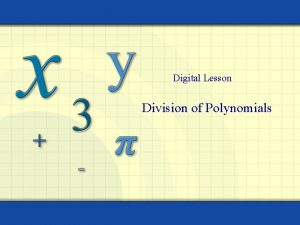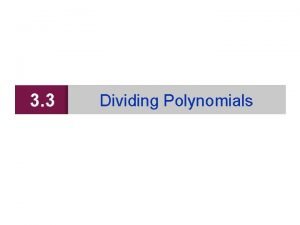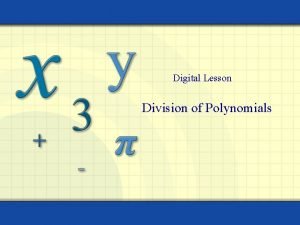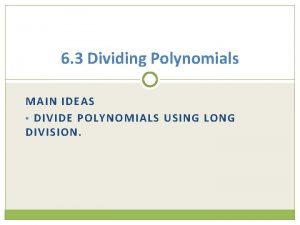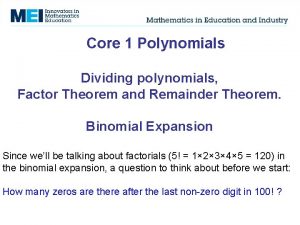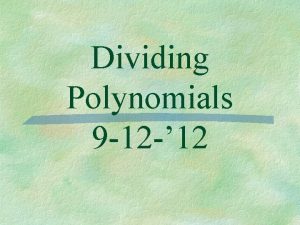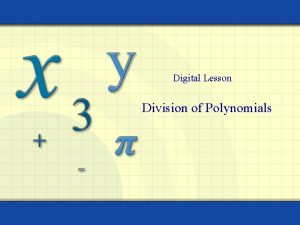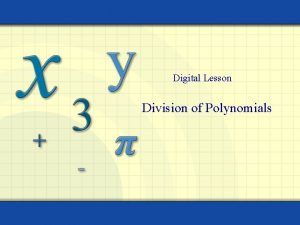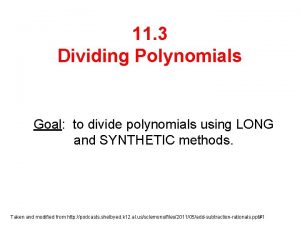Dividing Polynomials n r a e ull l
















- Slides: 16

Dividing Polynomials n r a e u’ll l o y t a h W To divide polynomials using long division. To divide polynomials using synthetic division. To use the remainder Theorem of Algebra y r a l bu a c Synthetic division, Remainder Theorem, Vo Algorithm: is an effective method expressed as a finite list of well-defined instructions for calculating a function. Algorithms are used for calculation, data processing, and automated reasoning. In simple words an algorithm is a step-by-step procedure for calculations.

You can divide polynomials the same way that you divide whole numbers. 21 divides into 67 3 times 21 divides into 42 2 times

Problem 1: Using Polynomial Long Division Use polynomial long division to divide What is the quotient and remainder. Divide Multiply Remember - Subtract to get 3 x and bring down -16 Divide Multiply The quotient is with the remainder -31 So, this is the polynomial and is called divisor. .

You can say 4 x+3, R -31 and you can check it Your turn Use polynomial long division to divide What is the quotient and the remainder Answer 3 x-8, R 0

Note: the Division Algorithm for Polynomials You can divide polynomial P(x) by polynomial D(x) to get polynomial quotient Q(x) and polynomial remainder R(x). The result is P(x)=D(x)Q(x) +R(x) If R(x)=0, then P(x)=D(x)Q(x) and D(x) and Q(x) are factors of P(x). To use long division, P(x) and D(x) should be in standard form with zero coefficients where appropriate. The process stops when the degree of the remainder, R(x) is less than the degree of the divisor, D(x).

Problem 2: Checking Factors A. Include 0 x terms Remember - The remainder The degree of the remainder is less than the degree of the divisor. STOP! is not a factor of

B. Step 1: Use the factor theorem that said: the expression x-a is a factor of a polynomial if and only if the value a is a zero of the related polynomial. Since P(2) =0 then x-2 is a factor of P(x) Step 2: Use the long division to find the others factors So

Your turn Answer:

Take a note There is another way to do the long division and it is called the synthetic division, this method simplifies the long division process by dividing by a linear expression x-a. to use synthetic division, write the coefficients including zeros of the polynomial in standard form. Omit all variables and exponents. For the divisor, reverse the sign (use a). This allows you to add instead of subtract throughout the process.

3 3 9 15 36 5 12 34

To check your answer use the long division.

Your turn Answers:

Your turn again The polynomial expresses the volume, in cubic inches, of the shadow box shown. A. What are the dimensions of the box? B. If the width of the box is 15 inches, what are the other two dimensions? Answer: w=10 inches l=18 inches h=4 inches

A theorem is a statement that has been proven on the basis of previously established statements, such as other theorems, and previously accepted statements. The Remainder theorem: If you divide P(x) of degree by x-a, then is P(a). Here’s why it works when you divide polynomial P(x) by D(x), you find P(x)=D(x)Q(x)+R(x) P(x)=(x-a)Q(x)+R(x) Substitute (x-a) for D(x) P(x)=(a-a)Q(a)+R(a) Evaluate P(a). Substitute a for x =R(a) Simplify

Problem 4: Evaluating a polynomial Given , What is P(3)? By the remainder theorem P(3) is the remainder when you divide P(x) by x-3 Answer: P(3)=182 Your turn Given that Answer: P(-4)=0 What is P(-4)?

hahahhh Classwork odd Homework even TB pgs 308, 309 Exercises 9 -39 and 44 -62
 How is dividing rational numbers like dividing integers
How is dividing rational numbers like dividing integers Dividing polynomials by binomials
Dividing polynomials by binomials 6 . 5 dividing polynomials
6 . 5 dividing polynomials Real life examples of addition
Real life examples of addition Lesson 6-5 dividing polynomials worksheet answers
Lesson 6-5 dividing polynomials worksheet answers Dividing polynomials with exponents
Dividing polynomials with exponents Unit 5 polynomial functions homework 2
Unit 5 polynomial functions homework 2 Synthetic substitution example
Synthetic substitution example Dividing polynomials math lib
Dividing polynomials math lib 11-5 practice dividing polynomials answer key
11-5 practice dividing polynomials answer key 3-4 lesson quiz dividing polynomials
3-4 lesson quiz dividing polynomials Adding subtracting multiplying and dividing polynomials
Adding subtracting multiplying and dividing polynomials 5-2 dividing polynomials
5-2 dividing polynomials Division of polynomial by monomial
Division of polynomial by monomial Synthetic division worksheet doc
Synthetic division worksheet doc How to divide polynomials using long division
How to divide polynomials using long division 6-3 dividing polynomials
6-3 dividing polynomials
